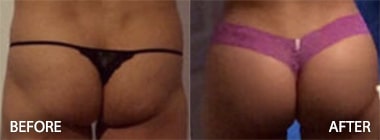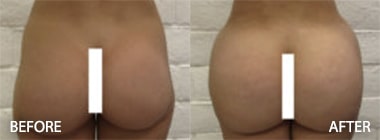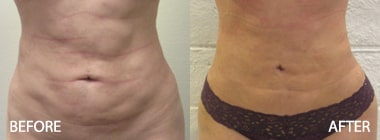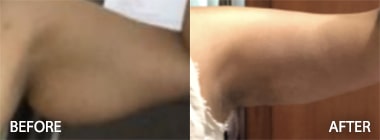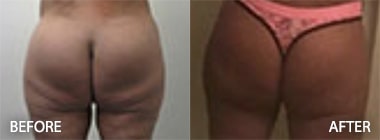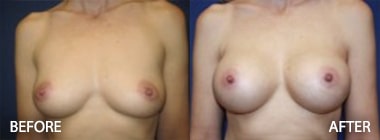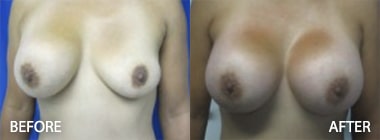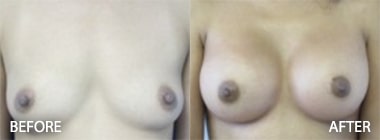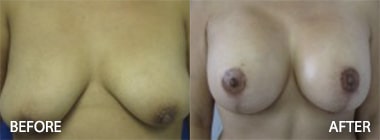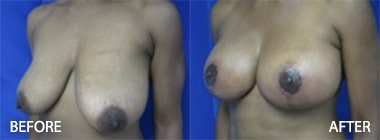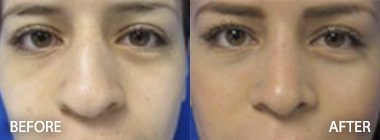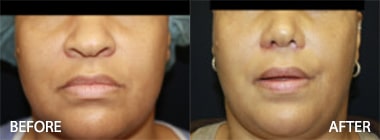
Jump To:
Dr. Kenneth Hughes performs a great number of dead fat removal surgeries Los Angeles and Beverly Hills, CA. Many times patients have run out of options or have no options when they seek out Dr. Hughes’s expertise for a revision. Dr. Hughes sees patients who have been to 20 or 30 consultations looking for an answer and have been turned away. This presents a unique situation in which Dr. Kenneth Hughes possesses the tools and skills to remedy a situation that others do not.
The removal of dead fat also called fat necrosis can be a daunting task. Although small areas of fat necrosis may improve over a period of time, the dead fat can be debilitating to daily tasks and can cause chronic pain particularly with sitting, standing, or reclining. Dr. Kenneth Hughes has removed huge bricks of dead fat from patients’ buttocks and hips and many other areas as well. This always necessitates an incision due to the very high density of the dead fat.
Dead fat cannot simply be removed by the liposuction process or with any type of liposuction technique. Liposuction can only remove lower-density materials through the power of vacuum suction. The results when the fat dies due to lack of blood supply and dystrophic calcification occurs. The result of this process is a hard, calcified, very dense brick of dead tissue. This dead tissue must be cut out or excised. Many of these patients have undergone Brazilian butt lift or BBL from another surgeon and have developed fat necrosis from the fat transfer procedure. This is a known complication of BBLs but is not a complication of butt implant procedures. Fat necrosis can also occur from any sort of trauma including antibiotic and steroid injections in the buttocks or other fatty areas.
Dr. Hughes can frequently remove the dead fat in one surgery and provide the patient with a good cosmetic result at the same time. Sometimes, if the dead fat volume is very large, more than one surgery may be necessary, as well as reconstruction.
AM I A GOOD CANDIDATE FOR FAT NECROSIS REMOVAL?
Patients who do not have any pre-existing conditions that affect the healing process are ideal candidates for fat necrosis removal. Non-smokers are preferred since smoking can negatively affect recovery. If you are a smoker and are in need of fat necrosis removal, it will be best to avoid smoking for several weeks before the procedure date and for at least 8 weeks after surgery. This can be discussed during a consultation with Dr. Kenneth Hughes at his office in Los Angeles and Beverly Hills, CA.
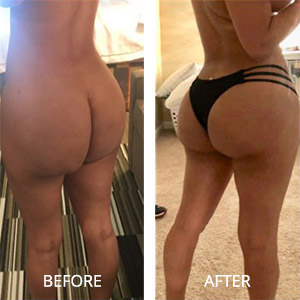
Schedule a Consultation with Hughes Plastic Surgery
Patients who are in need of this procedure must schedule a consultation with Dr. Hughes. During the consultation, Dr. Hughes will ask questions regarding the location of the dead fat, potential causes, symptoms, and the patient’s medical history. This can include information about allergies, past procedures, and current medications.
Dr. Hughes will examine the problem areas carefully to determine how to best approach the removal of the dead fat. He will create an effective and safe surgical plan, which he will discuss with the patient to ensure understanding. If the patient has any questions or concerns regarding the procedure, they can bring them up at this point.
Incision Placement and Strategy in Fat Necrosis Removal Surgeries
Fat necrosis cannot be removed with liposuction due to the greater density of the dead fat. Attempts to liposuction fat necrosis will only remove the living fat around the fat necrosis. Additionally, trying to transfer fat to the fat necrosis will only lead to more dead fat.
The dead fat must be removed with an incision. The question is where to place the incision and how long to make the incision. A patient obviously wants to have as inconspicuous a scar as possible. In many cases, Dr. Kenneth Hughes makes the incision under the buttock, at the top of the buttock, or within a tattoo or scar. Dr. Hughes then dissects the level of fat necrosis for removal. Dr. Kenneth Hughes performs this with the help of a lighted retractor so that he can both visualize the offending fat necrosis and feel for the dead fat with his opposing hand.
Sometimes the necrotic tissue is hard throughout and is removed as a brick. Sometimes, the dead fat has a hard outer shell and the inside contains more liquid material. Either way these are good things to remove because the removal reduces pain, can reduce contour deformities, and reduces the risk of future infection.

Most recently, Dr. Kenneth Hughes removed a great deal of dead fat from an individual and then removed a great deal of skin from the buttock fold at the same time. This procedure accomplished two goals for the patient: 1) the patient wanted to remove the obviously hard, dead calcified fat and 2) the patient wanted to make the area appear smoother and make the buttocks appear shorter and rounder without a lot of loose, hanging skin. Dr. Hughes was able to improve all of these aspects with one surgery with the inferior buttock lift incision.
The inferior buttock lift surgery is a surgery that very few surgeons perform or perform in a certain way. The goal of the procedure is not to flatten the buttock or to reduce the buttock/leg definition, but rather it is to tighten the skin of the posterior thigh and improve the buttock shape as well as the sagging or droopiness of the buttocks.
Sometimes Dr. Kenneth Hughes utilizes this approach in conjunction with the lower body lift incision and/or fat grafting. Sometimes, the removal of the dead fat is done at one time with the inferior buttock lift. In the future, the patient can be reconstructed with fat grafting or implants to improve the areas of removal if necessary.
FAT NECROSIS REMOVAL AFTERCARE
Following the removal of dead fat, patients are advised to rest and relax as much as possible during their recovery period. Avoid putting pressure on the affected area, and follow the post-surgical care instructions provided by Dr. Hughes as closely as possible.
Swelling and bruising may be present for a time in the treatment area. Wearing post-surgical garments may be recommended to control swelling. Time off from work may be required. Drains are usually placed for a period of 3 weeks to reduce the risk of fluid collections and incision separation. Healing usually required 6 to 8 weeks, during which time the patient should abstain from strenuous activity of any kind.
Fat Necrosis Testimonials and Reviews for Dr. Kenneth Hughes
I’m so happy with my results
My experience was great. I love Dr. Hughes and his staff they were very welcoming and made me feel very comfortable. As this was a hard decision for me and I’m so happy with my results. I had fat necrosis removal with a bilateral lift due to a botched job I had done in Mexico. I’m 1 week post-op. Thank you Dr. Hughes and your staff.
Cost of the Surgery in Los Angeles and Beverly Hills, CA
One Area of Buttock Fat Necrosis Removal (simple) cost — $7000
One Area of Buttock Fat Necrosis (complex, large, or multiple areas) cost — $10,000 to $15,000
Bilateral Buttock Fat Necrosis Removal (simple) cost — $12,000 to $14,000
Bilateral Buttock Fat Necrosis Removal (complex, large, 0r multiple areas) cost — $12,500 to $20,000 or more
Please note that fat necrosis can occur in many other areas of the body, and Dr. Kenneth Hughes has removed dead fat from the face, lips, neck, breasts, abdomen, hips, legs, calves, and arms.
Before Big Butt Lift and Fat Necrosis Removal by Dr. Kenneth Hughes – VIDEO
After Big Butt Lift and Fat Necrosis Removal by Dr. Kenneth Hughes – VIDEO
Schedule a Consultation
Interested in learning more about fat necrosis removal in Los Angeles and Beverly Hills? Contact the office of Dr. Kenneth Hughes today to schedule an appointment. We look forward to offering compassionate treatment and excellent cosmetic plastic surgery solutions.
Related Procedures
Related Blog Posts
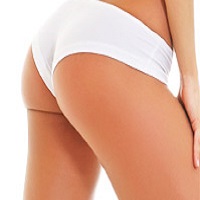 THE REMOVAL OF FAT NECROSIS OR DEAD FAT WITH FAT NECROSIS EXPERT DR. KENNETH HUGHES
THE REMOVAL OF FAT NECROSIS OR DEAD FAT WITH FAT NECROSIS EXPERT DR. KENNETH HUGHES
Dr. Kenneth Hughes, Los Angeles plastic surgeon, is an expert at fat necrosis removal in its various presentations. Fat necrosis is the death of fat that occurs… Read More
 SMOKING’S EFFECT ON PLASTIC SURGERY COMPLICATIONS INCLUDING FLAP DEATH, FAT NECROSIS, AND POOR WOUND HEALING
SMOKING’S EFFECT ON PLASTIC SURGERY COMPLICATIONS INCLUDING FLAP DEATH, FAT NECROSIS, AND POOR WOUND HEALING
Dr. Kenneth Hughes, Los Angeles plastic surgeon, understands the negative consequences of smoking on plastic surgery… Read More
